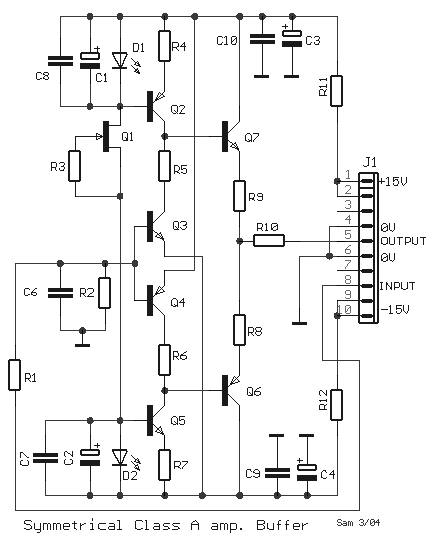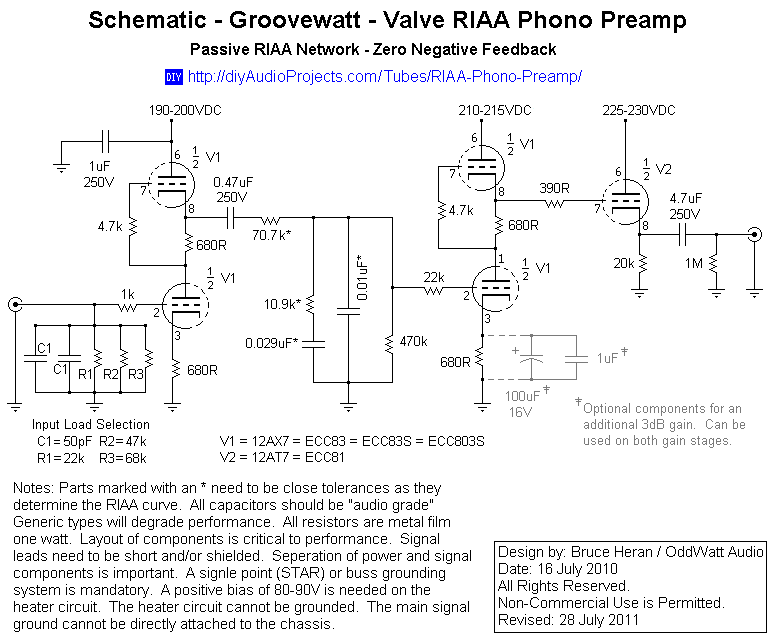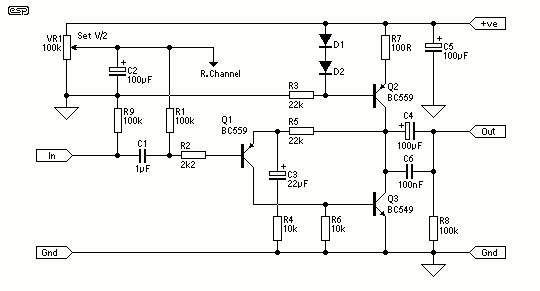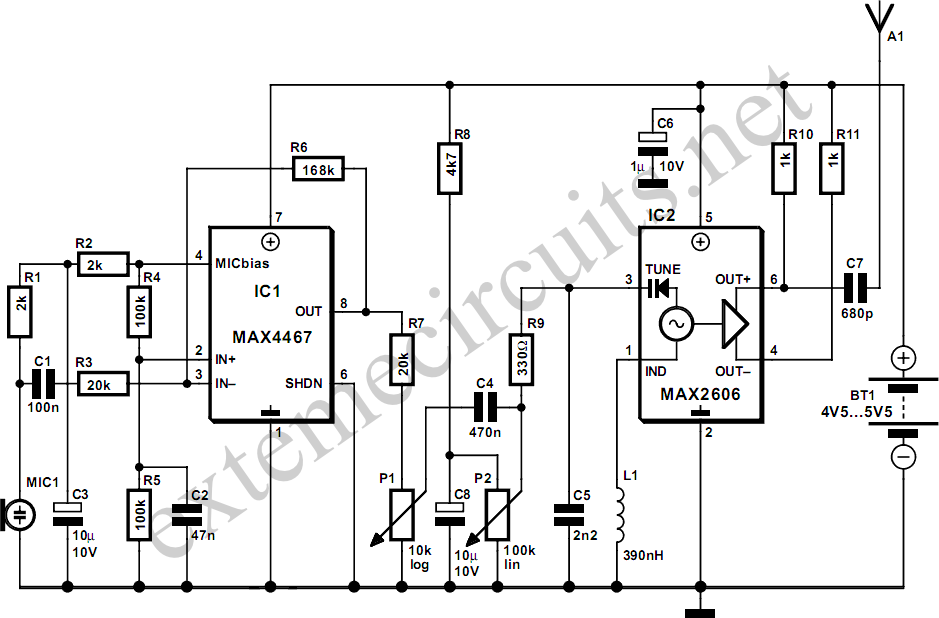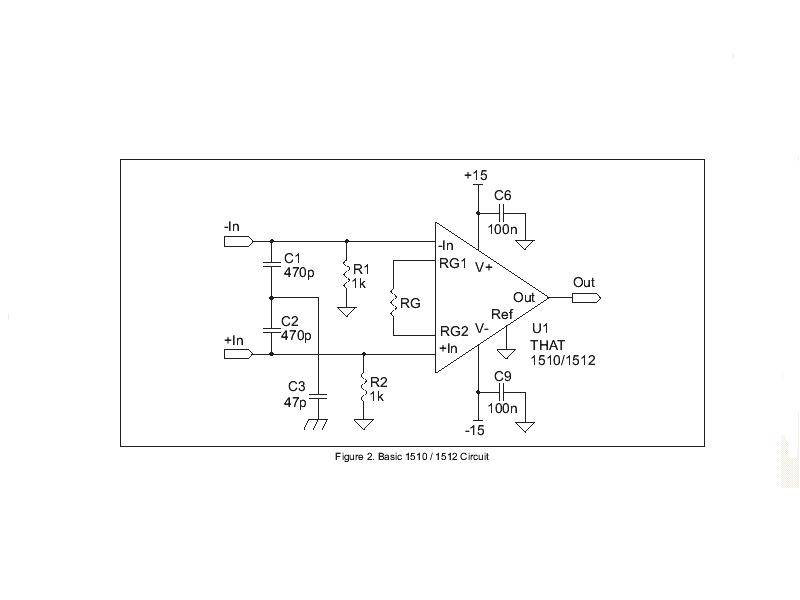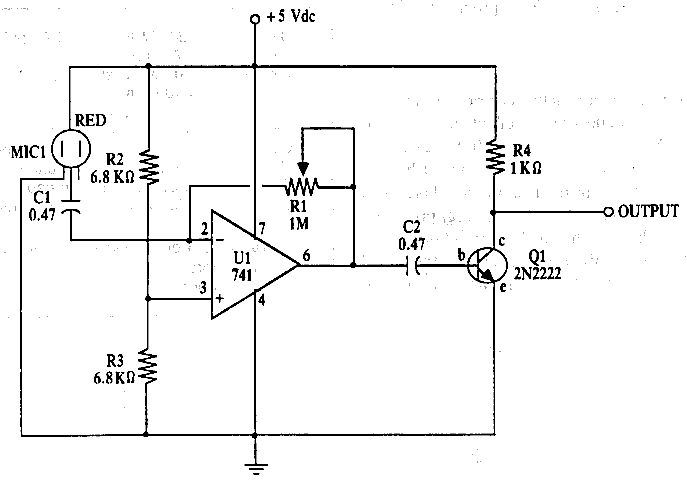
Op-Amp Microphone Preamp
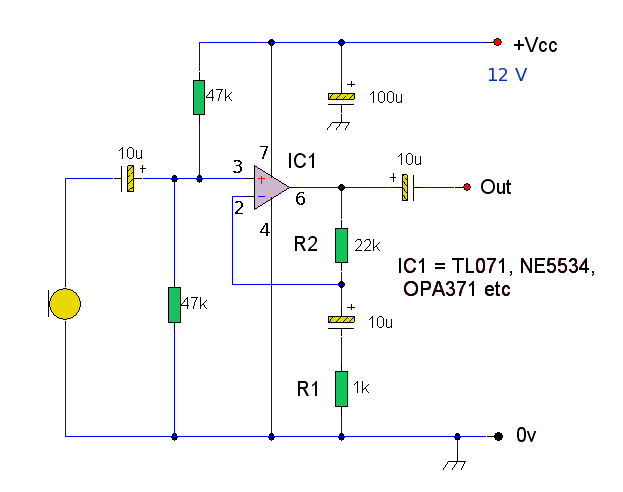
A high-quality microphone preamplifier utilizing a single power supply, suitable for both dynamic and electret microphones. The operational amplifier (op-amp) employed can be any low-noise, high-performance type, such as the NE5534, TL071, or OPA 371. The schematic illustrates the configuration with a dynamic microphone; for electret microphones, an appropriate biasing resistor is required to power the electret microphone. The pinout for the TL071 op-amp is provided. The design follows a standard non-inverting configuration, with the input connected to the non-inverting input of the op-amp, typically pin 3. The input impedance is 23.5 kΩ, and the overall voltage gain is determined by resistors R2 and R1, based on the formula provided. With the specified values of R2 and R1 in the diagram, the voltage gain at mid-band (1 kHz) is approximately 23 times or 27.2 dB. A Bode plot of the gain bandwidth is simulated using the TL071 op-amp. Operational amplifiers are characterized by high gain bandwidth products, rapid slewing rates, and extremely low noise levels, which makes achieving similar performance with discrete components challenging. The overall signal-to-noise ratio has been calculated, with the source being a 1 kΩ impedance microphone generating a 1 mV peak-to-peak sine wave. For those interested in constructing a variable gain amplifier, R1 can be replaced with a 2.2 kΩ preset or potentiometer. Line-out levels depend on the type of microphone used, as well as the proximity and loudness of the speaker.
The microphone preamplifier circuit is designed to offer a robust solution for amplifying low-level audio signals from microphones, ensuring high fidelity and minimal noise. The use of a single power supply simplifies the design, making it suitable for portable applications. The choice of op-amp is critical; low-noise, high-performance op-amps like the TL071 are preferred for their excellent specifications, including low total harmonic distortion and high slew rates, which are essential for accurately reproducing audio signals.
The non-inverting configuration allows for easy integration into various audio systems, providing high input impedance, which is crucial for interfacing with microphones without loading them down. The gain configuration, dictated by R1 and R2, is adjustable, allowing for flexibility in applications where different microphone sensitivities may be encountered. The calculated gain of approximately 23x ensures sufficient amplification for typical audio signals while maintaining clarity and detail.
The Bode plot serves as a valuable tool for analyzing the frequency response of the amplifier. It provides insights into how the gain varies with frequency, which is essential for ensuring that the amplifier performs well across the audio spectrum, particularly in professional audio applications.
The inclusion of a variable gain option enhances the versatility of the design, allowing users to adapt the amplifier to different recording environments or microphone characteristics. This feature is particularly beneficial in live sound applications where the distance from the microphone to the sound source can vary significantly.
In summary, this microphone preamplifier circuit is an efficient and effective solution for audio signal amplification, suitable for both dynamic and electret microphones, with a design that emphasizes low noise and high performance.A high quality microphone preamplifier using a single power supply, suitable for dynamic or electret microphones. The op-amp used can be any low noise, high performance type, e. g. NE5534, TL071, OPA 371 etc Nothing too special here. The schematic is shown using a dynamic microphone, for use with an electret a suitable biasing resistor is required t
o power the electret microphone, see this page for more help. The pinout for the TL071 is shown below: The design is a standard non-inverting design, the input is applied to the non-inverting input of the op-amp which is pin 3 in most cases. The input impedance is 23. 5k, the overall voltage gain is determined by R2 and R1according to the following formula: With the values of R2 and R1 on the diagram the voltage gain (for mid band, 1KHz) is approximately 23x or 27.
2dB The gain bandwidth (bode) plot is shown below. This plot is simulated using the TL071 op-amplifier. Operational amplifiers feature high gain bandwidth products, have a fast slewing rate and have extremely low noise. It is difficult to achieve the same performance using discrete components. Finally the overall signal to noise ratio has been calculated, the source was a 1k impedance microphone generating a 1mV pk-pk sine wave.
For anyone wanting to build a variable gain amplifier, then R1 can be change to a 2. 2k preset or potentiometer. Line out levels depends on the microphone used and proximity and loudness of the person speaking. 🔗 External reference
The microphone preamplifier circuit is designed to offer a robust solution for amplifying low-level audio signals from microphones, ensuring high fidelity and minimal noise. The use of a single power supply simplifies the design, making it suitable for portable applications. The choice of op-amp is critical; low-noise, high-performance op-amps like the TL071 are preferred for their excellent specifications, including low total harmonic distortion and high slew rates, which are essential for accurately reproducing audio signals.
The non-inverting configuration allows for easy integration into various audio systems, providing high input impedance, which is crucial for interfacing with microphones without loading them down. The gain configuration, dictated by R1 and R2, is adjustable, allowing for flexibility in applications where different microphone sensitivities may be encountered. The calculated gain of approximately 23x ensures sufficient amplification for typical audio signals while maintaining clarity and detail.
The Bode plot serves as a valuable tool for analyzing the frequency response of the amplifier. It provides insights into how the gain varies with frequency, which is essential for ensuring that the amplifier performs well across the audio spectrum, particularly in professional audio applications.
The inclusion of a variable gain option enhances the versatility of the design, allowing users to adapt the amplifier to different recording environments or microphone characteristics. This feature is particularly beneficial in live sound applications where the distance from the microphone to the sound source can vary significantly.
In summary, this microphone preamplifier circuit is an efficient and effective solution for audio signal amplification, suitable for both dynamic and electret microphones, with a design that emphasizes low noise and high performance.A high quality microphone preamplifier using a single power supply, suitable for dynamic or electret microphones. The op-amp used can be any low noise, high performance type, e. g. NE5534, TL071, OPA 371 etc Nothing too special here. The schematic is shown using a dynamic microphone, for use with an electret a suitable biasing resistor is required t
o power the electret microphone, see this page for more help. The pinout for the TL071 is shown below: The design is a standard non-inverting design, the input is applied to the non-inverting input of the op-amp which is pin 3 in most cases. The input impedance is 23. 5k, the overall voltage gain is determined by R2 and R1according to the following formula: With the values of R2 and R1 on the diagram the voltage gain (for mid band, 1KHz) is approximately 23x or 27.
2dB The gain bandwidth (bode) plot is shown below. This plot is simulated using the TL071 op-amplifier. Operational amplifiers feature high gain bandwidth products, have a fast slewing rate and have extremely low noise. It is difficult to achieve the same performance using discrete components. Finally the overall signal to noise ratio has been calculated, the source was a 1k impedance microphone generating a 1mV pk-pk sine wave.
For anyone wanting to build a variable gain amplifier, then R1 can be change to a 2. 2k preset or potentiometer. Line out levels depends on the microphone used and proximity and loudness of the person speaking. 🔗 External reference
Warning: include(partials/cookie-banner.php): Failed to open stream: Permission denied in /var/www/html/nextgr/view-circuit.php on line 713
Warning: include(): Failed opening 'partials/cookie-banner.php' for inclusion (include_path='.:/usr/share/php') in /var/www/html/nextgr/view-circuit.php on line 713
